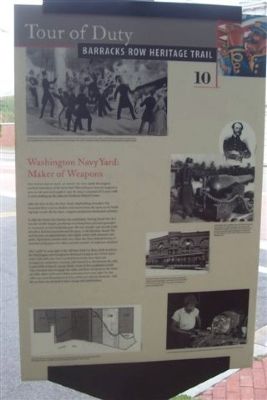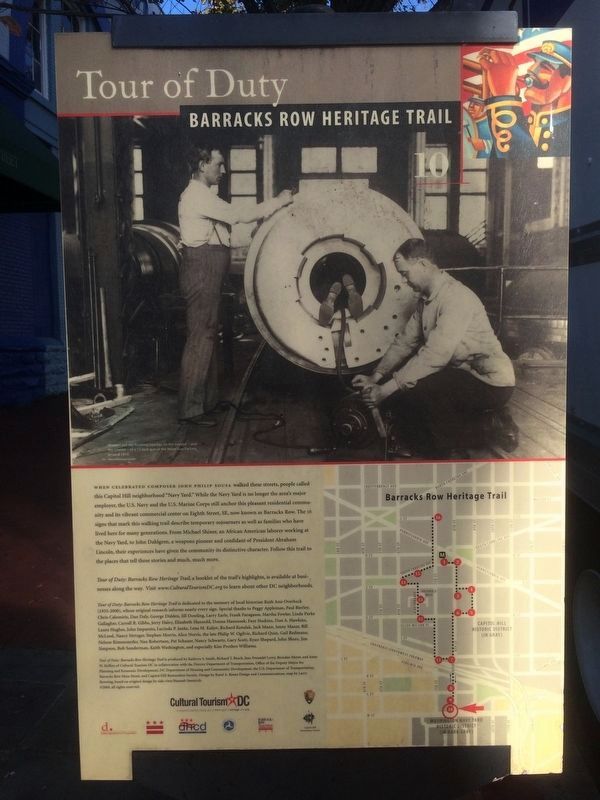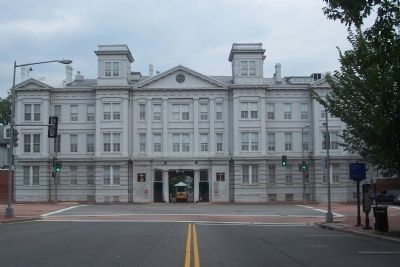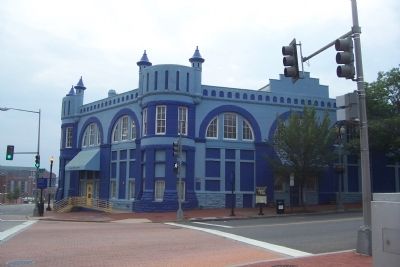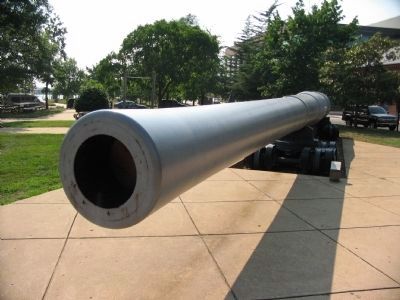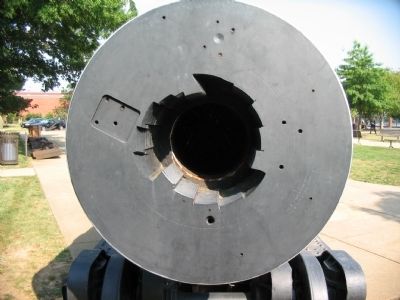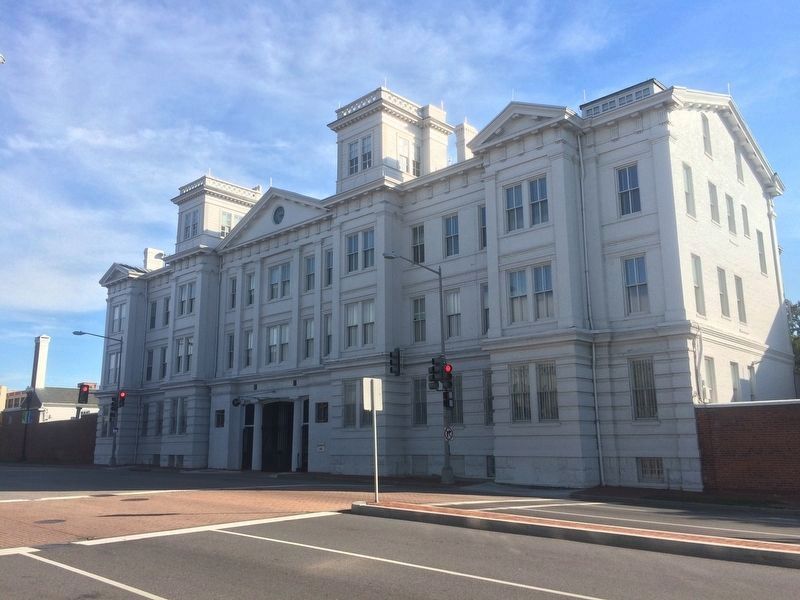Navy Yard in Southeast Washington in Washington, District of Columbia — The American Northeast (Mid-Atlantic)
Washington Navy Yard: Maker of Weapons
Tour of Duty
— Barracks Row Heritage Trail —
The white brick wall in front of you marks the original northern boundary of the Navy Yard. The yard grew from its original 12 acres to 128 acres at its peak in 1962. In 2003 it consisted of 73 acres with 55 acres making up the adjacent Southeast Federal Center.
After the War of 1812, the Navy Yard's shipbuilding dwindled. The Anacostia River was too shallow and remote from the open sea for building large vessels. By the 1840s, weapons production dominated activities.
In 1886, the Naval Gun Factory was established. During World War II it was the world's largest, producing everything from precision gunsights to enormous 16-inch battleship guns. By 1962 missiles and aircraft made elsewhere had decreased demand for guns, so the factories closed. The yard became an administrative and supply center, with museums and parks. Operations slowed until 2001, when the Navy adapted dozens of manufacturing spaces for offices and the number of employees doubled.
The "castle" to your right is the old Navy Yard Car Barn, built in 1891 by the Washington and Georgetown Railroad Company for a brief experiment with cable cars. Cars traveled between the Navy Yard and Georgetown, pulled by a moving cable buried in a slot between the rails. Capitol Hill resident J. George Butler wrote of how pranksters would "use a hooked wire to engage the cable, and then swoop down the street on roller skates until some killjoy policeman hove into sight." In 1897 cable cars were discontinued in favor of the new electric streetcars, and the car barn was devoted to their storage and maintenance.
Erected 2004 by Cultural Tourism DC. (Marker Number 10.)
Topics and series. This historical marker is listed in these topic lists: Military • War, World II. In addition, it is included in the Barracks Row Heritage Trail series list. A significant historical year for this entry is 1962.
Location. 38° 52.604′ N, 76° 59.705′ W. Marker is in Southeast Washington in Washington, District of Columbia. It is in Navy Yard. Marker is on 8th Street Southeast north of M Street Southeast, on the right when traveling south. Touch for map. Marker is at or near this postal address: 770 M St SE, Washington DC 20003, United States of America. Touch for directions.
Other nearby markers. At least 8 other markers are within walking distance of this marker. Washington Navy Yard: Serving the Fleet (a few steps from this marker); Serving as the City's Diplomatic Gateway (within shouting distance of this marker); Receiving Honored Servicemembers and Dignitaries (about 300 feet away, measured in a direct line); Latrobe Gate - Tingey House (about 300 feet away); The Washington Navy Yard (about 300 feet away);
William Prout: Community Builder (about 400 feet away); Teaching Sailors for the Fleet (about 400 feet away); Leutze Park Gun Collection (about 400 feet away). Touch for a list and map of all markers in Southeast Washington.
More about this marker. [Illustration captions:]
"Awful explosion of the Peacemaker" by N. Currier illustrates the 1844 accident that led to the creation of the Navy Yard's weapons testing facilities. A gun exploded during a VIP demonstration test, killing President John Tyler's Secretaries of State and Navy and nearly killing the President himself.
Commander John A. Dahlgren, top, the "father of American naval ordnance, "created a modern-style research and development program in the 1850s and invented the distinctive "soda-water bottle" shaped cannon in time for the Civil War. President Lincoln often visited his good friend Dahlgren here.
An electric streetcar, adapted from an earlier experimental cable car, awaits passengers on M Street in front of the Navy Yard Car Barn around 1902. In later years this building was known as the Blue Castle.
Over more than two centuries, the Navy
Yard has expanded along the Anacostia riverfront, erasing the original shoreline as landfill was added. Employment peaked in 1944 at 26,000.
In 1943 the National Youth Administration sent Juanita Gray to work on a metal lathe at the Navy Yard for $45 per week.
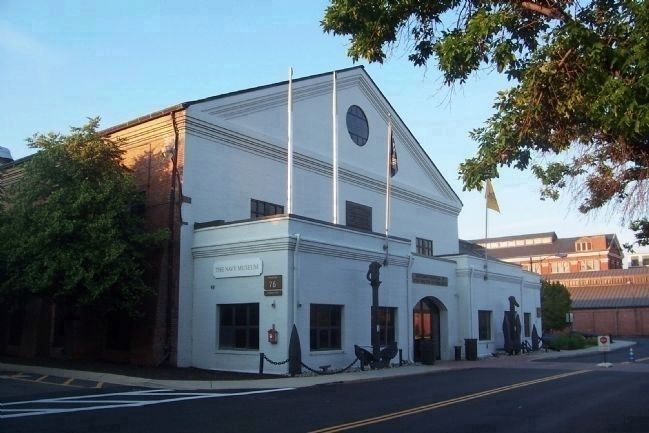
Photographed By Richard E. Miller, June 2008
5. Washington Navy Yard (Naval Gun Factory), Bldg. 76. The Navy Museum.
The Navy Museum which opened in 1963 is housed in Building 76, the former 600-foot-long Breech Mechanism shop of the Old Navy Gun Factory. The north end of the building was erected in the late nineteenth century and the southern portion was added in 1899. A 400-foot addition on the northern end, used for fitting liners and reinforcing hoops to gun barrels, was removed in the 1970s. The Museum contains exhibits which commemorate the Navy's wartime heroes and battles and peacetime contributions in the fields of science, diplomacy, and humanitarian service.
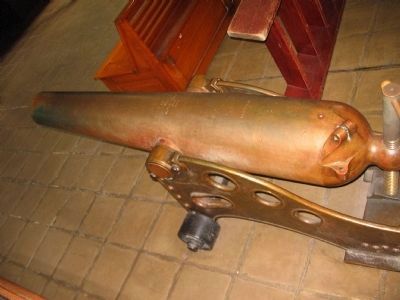
Photographed By Craig Swain, August 1, 2008
8. 20-pounder Dahlgren Rifle
Not all the Navy Yard Gun Factory products were large. This 20-pounder (4-inch bore) light rifled cannon, on display at the nearby Naval Museum, was produced at the Navy Yard in 1865. Intended for use on launches or light field carriages, this piece was one of a family of "boat howitzers" produced before, during, and after the Civil War at the Yard.
Credits. This page was last revised on January 30, 2023. It was originally submitted on August 29, 2008, by Richard E. Miller of Oxon Hill, Maryland. This page has been viewed 4,183 times since then and 25 times this year. Last updated on March 7, 2019, by Devry Becker Jones of Washington, District of Columbia. Photos: 1. submitted on August 29, 2008, by Richard E. Miller of Oxon Hill, Maryland. 2. submitted on December 2, 2016, by J. Makali Bruton of Accra, Ghana. 3, 4. submitted on August 29, 2008, by Richard E. Miller of Oxon Hill, Maryland. 5. submitted on September 2, 2008, by Richard E. Miller of Oxon Hill, Maryland. 6, 7, 8. submitted on August 29, 2008, by Craig Swain of Leesburg, Virginia. 9. submitted on December 2, 2016, by J. Makali Bruton of Accra, Ghana. • Bill Pfingsten was the editor who published this page.
